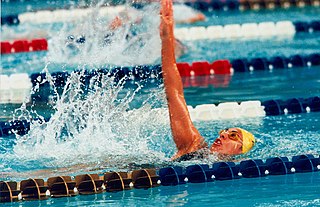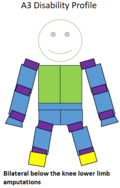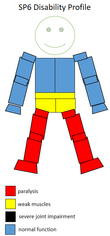
S8, SB7, SM8 are para-swimming classifications used for categorizing swimmers based on their level of disability. This class includes a number of different disabilities including people with amputations and cerebral palsy. The classification is governed by the International Paralympic Committee, and competes at the Paralympic Games.
S10, SB9, SM10 are para-swimming classifications used for categorizing swimmers based on their level of disability. Swimmers in this class tend to have minimal weakness affecting their legs, missing feet, a missing leg below the knee or problems with their hips. This class includes a number of different disabilities including people with amputations and cerebral palsy. The classification is governed by the International Paralympic Committee, and competes at the Paralympic Games.
S9, SB8, SM9 are para-swimming classifications used for categorizing swimmers based on their level of disability. Swimmers in this class generally have severe weakness in one leg. This class includes a number of different disabilities including people with amputations and cerebral palsy. The classification is governed by the International Paralympic Committee, and competes at the Paralympic Games.
S6, SB5, SM6 are para-swimming classifications used for categorising swimmers based on their level of disability. This class includes people with a number of different types of disability including short stature, major limb impairment or loss in two limbs. This includes people with cerebral palsy, people with dwarfism and amputees. The class competes at the Paralympic Games.
S5, SB4, SM5 are para-swimming classifications used for categorizing swimmers based on their level of disability. The class includes people with a moderate level of disability, and includes people with full use of their arms and hands, but limited to no use of their trunk and legs. It also includes people with coordination problems. A variety of disabilities are represented by this class including people with cerebral palsy. The class competes at the Paralympic Games.
S4, SB3, SM4 are para-swimming classifications used for categorising swimmers based on their level of disability. Swimmers in this class have coordination problems affecting all four of their limbs, or have movement in their arms, some trunk function and no leg function. Events this class can participate in include 50m and 100m Freestyle, 200m Freestyle, 50m Backstroke, 50m Butterfly, 50m Breaststroke, and 150m Individual Medley events. The class competes at the Paralympic Games.
S3, SB2, SM3 are para-swimming classifications used for categorising swimmers based on their level of disability. People in this class have some arm and hand function, but no use of their trunk and legs. They have severe disabilities in all their limbs. Swimmers in this class have a variety of different disabilities including quadriplegia from spinal cord injury, cerebral palsy and multiple amputations.
S2, SB1, SM2 are para-swimming classifications used for categorizing swimmers based on their level of disability. People in this class have limited use of their arms, and no or extremely limited use of their hands, legs and trunk. Swimmers in this class have a variety of different disabilities including cerebral palsy and amputations.
A2 is an amputee sport classification used by the International Sports Organization for the Disabled (ISOD).for people with acquired or congenital amputations. A2 sportspeople have one leg amputated above the knee. Their amputations impact their sport performance, including having balance issues, increased energy costs, higher rates of oxygen consumption, and issues with their gait.
A3 is an amputee sport classification used by the International Sports Organization for the Disabled (ISOD) for people with acquired or congenital amputations. A3 classified sportspeople have both legs amputated below knee. Their amputations impact their sport performance, including having balance issues, increased energy costs, higher rates of oxygen consumption, and issues with their gait. Sports people in this class are eligible to participate in include athletics, swimming, sitting volleyball, archery, weightlifting, badminton, lawn bowls, sitzball and wheelchair basketball.
A4 is an amputee sport classification used by the International Sports Organization for the Disabled (ISOD).for people with acquired or congenital amputations. People in this class have one leg amputated below the knee. Their amputations impact their sport performance, including having balance issues, increased energy costs, higher rates of oxygen consumption, and issues with their gait. Sports people in this class are eligible to participate in include athletics, swimming, sitting volleyball, archery, weightlifting, wheelchair basketball, amputee basketball, amputee football, lawn bowls, and sitzball.
A5 is an amputee sport classification used by the International Sports Organization for the Disabled (ISOD).for people with acquired or congenital amputations. A5 sportspeople are people who have both arms amputated above or through the elbow joint. Their amputations impact their sport performance, including being more prone to overuse injuries. Sports people in this class are eligible to participate in include athletics, swimming, cycling, lawn bowls, and sitzball.
A6 is an amputee sport classification used by the International Sports Organization for the Disabled (ISOD) for people with acquired or congenital amputations. People in this class have one arm amputated above or through the elbow joint. Their amputations impact their sport performance, including being more prone to overuse injuries. Sports people in this class are eligible to participate in include athletics, swimming, cycling, amputee basketball, amputee football, lawn bowls, and sitzball.
A7 is an amputee sport classification used by the International Sports Organization for the Disabled (ISOD) for people with acquired or congenital amputations. A7 sportspeople have both arms amputated below the elbow, but through or above the wrist joint. Their amputations impact their sport performance, including being more prone to overuse injuries. Sports people in this class are eligible to participate in include athletics, swimming, cycling, lawn bowls, and sitzball.
A8 is an amputee sport classification used by the International Sports Organization for the Disabled (ISOD).for people with acquired or congenital amputations. People in this class have one arm amputated below the elbow, but through or above the wrist joint. Their amputations impact their sport performance, including being more prone to overuse injuries. Sports people in this class are eligible to participate in include athletics, swimming, cycling, amputee basketball, amputee football, lawn bowls, and sitzball.
A1 is an amputee sport classification used by the International Sports Organization for the Disabled (ISOD) for people with acquired or congenital amputations. This class is for sportspeople who have both legs amputated above the knee. Their amputations impact their sport performance, including having balance issues, increased energy costs, higher rates of oxygen consumption, and issues with their gait. Sports people in this class are eligible to participate in include athletics, swimming, sitting volleyball, archery, weightlifting, badminton, lawn bowls, sitzball and wheelchair basketball.
F4, also T4 and SP4, is a wheelchair sport classification that corresponds to the neurological level T1- T7. Historically, it was known as 1C Incomplete, 2 Complete, or Upper 3 Complete. People in this class have normal upper limb function, and functional issues with muscles below the nipple line.
F5, also SP5, is a wheelchair sport classification that corresponds to the neurological level T8 - L1. Historically, it was known as Lower 3, or Upper 4. People in this class have some trunk function and good sitting balance. They have problems with hip function, that reduces their ability to rotate their spines.
F6, also SP6, is a wheelchair sport classification that corresponds to the neurological level L2 - L5. Historically, this class has been known as Lower 4, Upper 5. People in this class have good sitting balance, and good forward and backward movement of their trunk. They have some use of their thighs and can press their knees together.
F7, also SP7, is a wheelchair sport classification that corresponds to the neurological level S1- S2. Historically, it has been referred to as Lower 5. It is characterized by people having their lower limb muscles strength and function impacted. People in the SP7 class generally have good sitting balance and some trunk movement backwards and forwards. One side may be stronger than the other.











